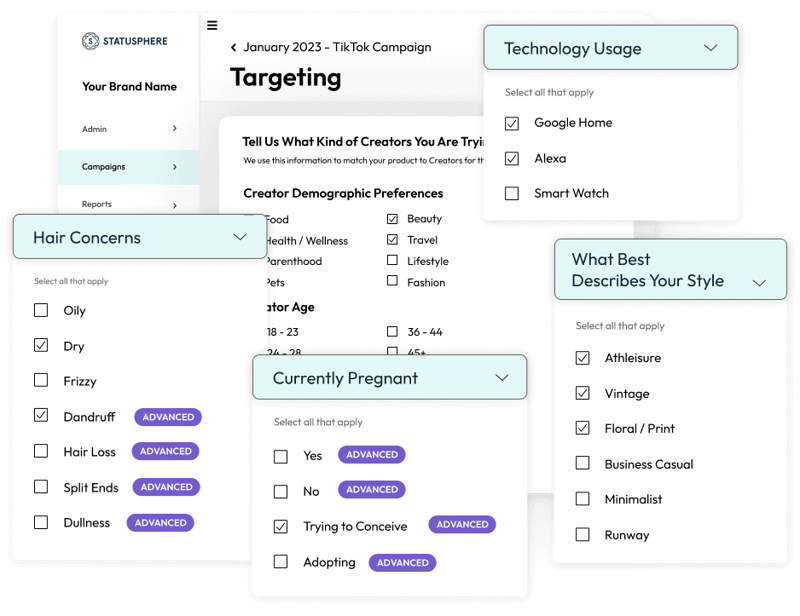TikTok Micro-Influencers: Why Smaller Creators are Best for Brands
TikTok micro-influencers generate authentic content and organic engagement for brands. Below we break down the benefits of micro-influencers on...
Consumer brands are under pressure to squeeze more from their influencer campaigns. Below are five proven CPG influencer marketing tactics for brands to test!


When it comes to influencer marketing for CPG brands, the stakes are high.
Because CPG brands in hyper-competitive spaces like beauty, food and home goods have the most to gain from scaling influencer collabs.
Especially when the impact of real-world recommendations is bigger than ever.
Word-of-mouth is make or break in the CPG space. That's why sourcing high volumes of positive reviews and influencer content are priorities to break through the noise.
Dominating your category demands more than just content, though. Effective influencer marketing means stretching the reach and returns from your campaigns.
Below we break down influencer strategies for CPG brands to help you do exactly that!
Skip to Section 👇5 Next-Level CPG Influencer Marketing Tactics |
B2C brands across the board are increasing their investment in influencers for good reason.
And if you want to unlock the full potential of your creator content, scaling is key.
Chances are you're already running your fair share of influencer campaigns. You're also likely sitting on a ton of existing influencer content already, right? If so, that's great news!
But where do you go from here? How can you maximize you results beyond the basics?
Consider how you can increase the impact and ROI of your current creators and future content with the CPG influencer marketing strategies below.
Influencers don’t just drive online traffic.
And these days, in-store purchases and online awareness go hand-in-hand.
While some shoppers prefer to research products online before buying in-store, others do the opposite. Either way, in-store influencer activations can maximize your reach regardless.
Retail support can be woven directly into your existing influencer marketing strategy by having creators post about their in-store shopping experiences. In-store content is a prime way to support your retail channel partners and drive direct action from your target audience.
Seeing creators physically buying a product gets consumers excited to make their own brick-and-mortar purchases. For example, Alodia Hair Care partnered with Stautsphere creators to drive in-store purchases at Target.
The brand earned 343,000+ likes across its retail influencer content. Check out this shopping spree-inspired creator post that generated a flood of positive engagement on TikTok.

Source: @rnabna
Consumers love to virtually tag along on influencers’ shopping trips. This is especially true on TikTok. For reference, the #ComeShoppingWithMe tag has over 60+ million posts by itself.
Influencer content serves as a valuable touchpoint and plants the seed for consumers to toss your product in their cart the next time they’re out. Beyond supporting in-store purchases, retail-related content makes buying your product more actionable for shoppers.
Maybe you're tired of hearing that "social media is the new Google."
But you don't have to look hard to find examples of social SEO as product-related searches continue to dominate both TikTok and Instagram.
When it comes to sales, the stakes for CPG influencer marketing just got higher with the recent boom of TikTok Shop and its millions of dollars in sales driven already. Positive reviews are like gold as social becomes the go-to search engine for consumer packaged goods.
That’s why ranking for relevant search terms should be a staple of influencer marketing for CPG brands. The more creators post and promote your product at scale, you more likely you are to rank. High volumes of product reviews from micro-influencers can cement your rankings.
The rise of TikTok SEO is well documented and something we've seen firsthand. For example, Viori partnered with 1,000+ influencers using Statusphere's micro-influencer marketing platform to dominate rankings for terms on TikTok like "shampoo bar" and "conditioner bar."


Considering these tags have a combined 100s of millions of views and posts, consider the value of higher rankings. This goes hand in hand with driving brand awareness and sales, which the brand actually notes in this case study.
The product-focused nature of the social search applies to industries beyond beauty, too. For example, tags like #CleanTok and #BestSupplements have amassed a cumulative millions of posts and billions of views on TikTok.
Think your product is too niche? Think again!
From #SnailMucin to #EyebrowThreading, nothing is off limits on TiKTok. The diversity of brands and products promoted on the app has made it a hub of B2C influencer marketing.
If you haven't already, consider how you can start building your social media keyword list and incorporate those terms into your influencer content, creative briefs and beyond.
For example, a CPG influencer marketing for a cleaning product targeting new moms might go after search terms like:
Ranking for product-related terms is a key step to reaching your target audience and growing your reach. Again, ranking organically requires a high volume of consistent content.
This highlights the value of a micro-influencer marketing platform (like Statusphere!) that guarantees creator content at scale. More influencers posting on behalf of your brand means higher chances of ranking and satisfying search intent.
If you’ve already earned top-tier creator content, don’t stop there!
Partnering with those same creators again and again is a natural next step.
Influencer marketing for CPG is all about playing the long game. That means retaining creators long-term and building an influencer community that knows and loves your products.
Consider how stop-and-go influencer campaigns struggle to build momentum. On the flip side, always-on influencer marketing supports a steady influx of content, builds relationships and produces ongoing results that compound over time.
And that's a win-win for brands and creators alike!
The longer you work with the same high-performing creators, the more they’ll understand your product, how to communicate its benefits and how to resonate with your target audience.
For example, below are two separate posts from the same creator that saw high engagement for one of our pet brands within our platform.


Source: @essie.aspen / @essie.aspen
The caveat? Re-engaging creators in-house requires some legwork.
And if you’re working with an agency, re-engagement requires tracking down creators one by one, which can become a massive time-sink.
That's why we built creator re-engagement directly into our platform. With Statusphere, brands can reactive creators for campaigns in a single click. Getting top-performing creators re-engaged faster means more chances to expand your reach, rank and nurture customers.
Our take? CPG brands should prioritize fostering relationships and getting the best content possible, not chasing down content or drowning in DMs. Creators should likewise prioritize collabs with brands they legitimately love. Again, win-win!
It's no coincidence that you're seeing more UGC in ads than ever before.
Consider how TikTok ads featuring creators earn a whopping 83% more engagement than traditional branded ads. We've likewise seen a spike in brands promoting their organic TikTok videos as Spark Ads.
Leveraging UGC to boost paid performance is becoming a staple tactic of influencer marketing for CPG brands. If you're already working with a high volume of creators, influencer ads are a prime way to translate organic content into conversions.
Not only is featuring UGC in ads a low-hanging way to repurpose content but it also stretches your influencer ROI by saving you time on producing ad creatives in-house.
For example, influencer whitelisting (AKA allowlisting) seamlessly transforms your best influencer content into high-performing ads on Instagram and TikTok.
This Instagram promotion from Vegamour is a shining example of a CPG brand doing influencer ads right. The creator’s authenticity brings the product to life and the results speak for themselves. Note how the ad earned a whopping 24.9K likes and 700+ comments.

Influencer ads are particularly powerful assets when you have well-crafted influencer briefs and a network of skilled creators who know what strong branded content looks like.
That said, the process of turning organic influencer content into ads can be a major hassle for busy brands, especially if you’re juggling promotions and multiple marketing channels. Getting content rights and explicit permission from creators is time-consuming but non-negotiable.
The alternative to this is to use an influence platform with built-in influencer content rights. For example, Statusphere's platform makes it possible to turn an influencer's video on TikTok into a Spark Ad in just two clicks. With our platform, brands get instant ad codes and creators get compensated without sending a single DM or negotiating rates.
Partnering with influencers at random won’t generate the most quality, on-brand content.
Taking your CPG influencer marketing strategy beyond the basics means finding creators who are already familiar with your industry and the pain points associated with your audience.
The more niche-specific your influencers are, the better they’ll be able to resonate with potential customers. Of course, sifting through hundreds of profiles in search of relevant creators isn't exactly the best use of your time.
Even with a platform, most brands don’t have a way to target creators beyond basic demographics. Especially if you're relying on an unvetted database or list of influencers.
Brand-creator matchmaking based on general "industry" and basic demographics doesn't result in meaningful partnerships without serious digging and vetting. Again, that takes time.
On the flip side, a platform like Statusphere allows brands to get super granular with audience targeting and hone in on their ideal creator profile in a fraction of the time. That's because we use 250+ first-party creator data points to match brands with relevant influencers.

For example, let's say you're a beauty brand specializing in curly hair products. Our matchmaking will exclusively present your collab to curly-haired creators. Simple as.
But maybe you want to get even more specific and target creators with 3C or 5A curl types.
No problem! Our advanced options allow for highly specific targeting of niche audiences to ensure you get the best results possible. Granular targeting allows you to match with creators whose audiences most closely reflect your target demographics.
As a result, you’ll receive authentic content from people who actually care about using your product. For CPG brands, authenticity is crucial for the sake of social proof and word-of-mouth. Advanced matchmaking ensures the most authentic matches possible.
When it comes to influencer marketing for consumer brands, maximizing the mileage of your UGC is a must-do.
That means not only sourcing a high volume of content but strategically boosting, repurposing and optimizing it. Doing all of the above is made so much easier with a platform built for scale.
If you’re ready to take your CPG influencer marketing to the next level, Statusphere can help!
Our micro-influencer software matches brands with vetted influencers from our creator community using 250+ first-party data points. Unlike other platforms, we help brands earn a high volume of ongoing, guaranteed content with ad permissions included.
Statusphere also eliminates the most time-consuming pieces of working with influencers in-house thanks to our advanced matchmaking and fulfillment technology. We’ve already generated 75,000+ pieces of content for 400+ consumer brands.
Want to see how our platform works? Get in touch with one of our experts to learn how we can help you advance your influencer marketing efforts with guaranteed content at scale.

TikTok micro-influencers generate authentic content and organic engagement for brands. Below we break down the benefits of micro-influencers on...
Looking for TikTok influencer marketing examples? This post breaks down ten awesome campaigns and ideas to inspire brands working with TikTok...
Need to budget for influencer marketing? This post breaks down how to set a smarter influencer marketing budget to meet your brand's goals in 2024...
Be the first to know about the latest tools, trends and strategies in influencer marketing for brands.